Tag: microbiology’
Crock Pot Microbiology: Yogurt
- by KitchenPantryScientist
Microbes are always fighting for space.
Bacteria and fungi try to outnumber other tiny competitors using chemical warfare, among other things. That’s why many antibiotics (which kill certain bacteria) are actually produced by other bacteria. One reason foods like yogurt and cheese, which are made by beneficial bacteria like Lactobacillus acidopholis, don’t easily spoil is that these bacteria can turn milk sugars into lactic acid. This makes their environment toxic to some of their competitors, like pathogenic bacteria. Luckily, we humans aren’t harmed by lactic acid and can enjoy its tangy flavor.
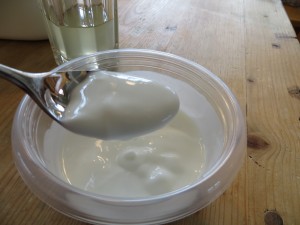
To grow bacteria in labs, scientists have to take care of them the way you’d take care of a pet. You have to give them the type of food they like, the right amount of oxygen and moisture, and keep them at their optimal temperature.
The same principles apply to growing the bacteria that make yogurt. You prepare the bacteria’s food by heating some milk and letting it cool to a temperature that the bacteria can tolerate. Then, you add the bacteria and let them grow for about eight hours. During that time, the bacteria will happily divide, multiply and eat milk sugar. In the process, they’ll produce lots of lactic acid which changes the way the proteins and fats in the milk interact, forming a more solid food product.
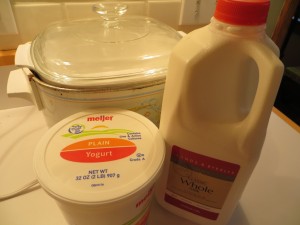
We made yogurt in our crock pot, which turned out to be a lovely bacterial incubator. The end product was a little runny, but putting it through cheese cloth (or a coffee filter in a plastic bag with the tip cut off) gives you thicker yogurt. It is delicious! Here’s how we made it, thanks to directions from Stephanie O’Dea:
Ingredients: 8 cups (half-gallon) of whole milk , 1/2 cup grocery store yogurt (must contain live/active culture), thick bath towel, slow cooker
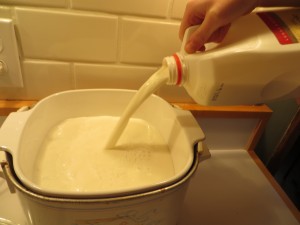
Turn crock pot on to low. Add an entire half gallon of milk. Cover and cook for 2 hours and 30 minute. Unplug your crock pot, but leave the cover on. Let it sit for 3 hours so your bacteria will not be overheated when you add them.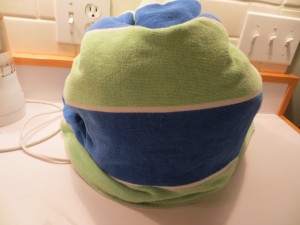
After 3 hours, put 2 cups of your warm milk in a bowl. Whisk in 1/2 cup of the live/active culture yogurt. Dump the bowl contents back into the crock pot and stir well. Wrap a heavy bath towel all the way around the unplugged crock pot as insulation and let your bacteria grow for 4-8 hours or until thickened. Refrigerate and enjoy with fruit, honey, or granola. As I mentioned, you can strain the yogurt if you prefer a thicker consistency, and your homemade yogurt will make a great starter culture for the next batch!
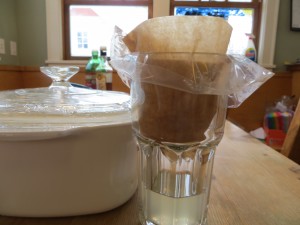
If you don’t have cheesecloth, you can strain your yogurt through a coffee filter in a plastic bag with a corner cut off.
Happy kitchen microbiology!
Homemade Petri Plates- Microbial Zoos
- by KitchenPantryScientist
 I’m re-posting this project we did two years ago, since I’m making plates today for a hand-washing experiment that the kids and I will do after school. Stay tuned!
I’m re-posting this project we did two years ago, since I’m making plates today for a hand-washing experiment that the kids and I will do after school. Stay tuned!
Did you know that every surface in your home is teeming with microorganisms? Culturing microbes from your home on petri dishes lets you grow some of them as colonies that you can see with your naked eye. You might already have what you need in your kitchen cupboard. If not, the ingredients are readily available at most grocery stores. I demonstrated this experiment on Kare11 and you can watch it here, following the yeast experiment.
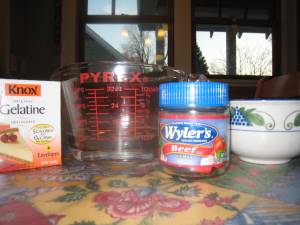 To make petri plates, you’ll need disposable containers (see below), beef bouillon cubes or granules, plain gelatin or agar agar*, water, sugar and Q-tips. (*Agar-agar can be found with Asian groceries in some grocery stores.) **Gelatin will melt if it gets too warm, and some strains of bacteria can liquify it, which is why scientists in labs use agar to make their plates. The idea to use agar for plates originally came from Angelina Hess, who used agar for canning food.
To make petri plates, you’ll need disposable containers (see below), beef bouillon cubes or granules, plain gelatin or agar agar*, water, sugar and Q-tips. (*Agar-agar can be found with Asian groceries in some grocery stores.) **Gelatin will melt if it gets too warm, and some strains of bacteria can liquify it, which is why scientists in labs use agar to make their plates. The idea to use agar for plates originally came from Angelina Hess, who used agar for canning food.
For containers, you can use foil muffin tins, clear plastic cups covered with plastic baggies, clear Tupperware with lids, or real petri dishes. We’re going to use clear deli containers, so that we can recycle while we learn. (Containers must be heat-resistant enough to pour warm agar into.)
Start by making microbial growth medium (or microbe food, as we like to call it.) Mix together:
–1 cup water
-1 Tbs. agar-agar (OR one and one half packages gelatin, which is about one and a half oz or 12g)
–1 bouillon cube (or 1 tsp. granules)
–2 tsp. sugar
The next step requires adult assistance, since it involves very hot liquid. Bring the mixture to a boil on the stove or in the microwave, stirring at one minute intervals and watching carefully until the gelatin or agar is dissolved. Remove the boiling liquid from heat and cover. Let cool for about fifteen minutes.

Pour the medium carefully into clean containers, until 1/3 to 1/2 full. Loosely place lids, foil or plastic baggies over containers and allow dishes to cool completely. The geltin or agar should make the growth media hard like jello. When your plates have hardened, store them in a cool place, like a refrigerator, before using. Plates should be used in 2-3 days. When you are working with the plates, try to keep the lids on loosely whenever possible, so that they are not contaminated by microorganisms floating around in the air. If you’re planning to use muffin tins, simply place them in a muffin pan, fill them with agar, and when they’re cool, put them in individual zip-lock baggies. With other containers, put the lids on tightly once the plates harden.



When the plates are ready, shake the condensation (water droplets) off the lids of the containers and put them back on. If you have a clear container, you can draw a grid of four sections on the bottom of the plate with permanent marker. (If using muffin tins, label each bag with the surface you are checking.) Decide which surfaces you’d like to test.
Label your plates with the names of the surfaces you want to test. Be sure to label the bottom of the plate since the lid will move. You should be able to see through the agar to see your lines and your writing. If you want to, you can label a separate plate for each surface, but we had three kids and three plates, so we made sections. TV remotes, kitchen sinks, computer keyboard, doorknobs and piano keys are great surfaces to check. You can even touch your finger to the plate, cough on a plate, or leave one open to the air for half an hour to see what’s floating around! (See the photo at the top of this post for a better picture of how your plate might look.)
Rub a clean Q-tip around on the surface you want to test. Then, remove the lid from the plate and gently rub the Q-tip across the section of the plate labeled for that surface. If you’re careful, the agar shouldn’t break. If it does, it’s no big deal. When you’re done, set the plates on a flat surface with their lids loosened and taped on (do not invert them.)
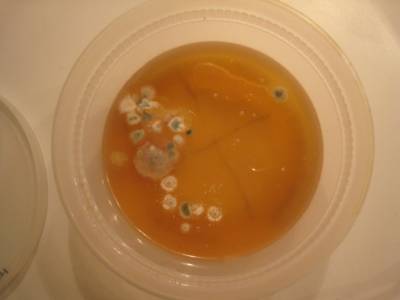
Here’s what grew on one of our plates (pictured above): The large, fuzzy colonies are fungi and the small, whitish ones are probably bacteria.
See what grows! You will mostly see fungi (molds), but you may also see some tiny clear or white spots that are colonies formed by millions of bacteria. Record and draw how your plates look in your science notebook. Keep track of how long it takes things to grow and the shapes, sizes and colors of the microbial colonies that grow on their plates. Sciencebuddies.org has this great page on interpreting what you find growing on your plates! If you want to learn more about microbes, search for the words fungi and bacteria on the website cybersleuthkids.com and it will give you some great links to microbiology websites. Microbes are everywhere, but that very few of them are harmful, and many of them are essential for good health.
Wash your hands after handling the plates, and throw the plates away when you are done. Remember, if you washyour hands with regular hand soap for the length of time that it takes to say the ABCs, you’ll remove most of the harmful bacteria and viruses on them. (One side effect of this experiment is the sudden urge to disinfect computer keyboards and remote controls.)
Jurassic Park- Closer Than We Think?
- by KitchenPantryScientist
When I told my husband that scientists at the J.Craig Venter Institute had assembled a funtioning bacterium from bottles of chemicals, he said exactly what I was thinking. “It’s like The Stand.” Even if you’re not a Stephen King fan, you’ve probably heard of his novel where a genetically engineered strain of the flu virus wipes out almost every human on earth.
USA Today, on the other hand, said “The long-anticipated advance, reported in the journal Science, is a $40 million milestone in the nascent field of “synthetic biology” and points towards a future of designer microbes manufacturing fuels, chemicals and materials.”
The news that a synthetic bacterium has been created comes as no surprise to most scientists. Even when I worked in a lab ten years ago, we cut and pasted bacterial DNA together on a regular basis. We also synthesized relatively short pieces of DNA by pushing buttons on a machine. The technology has vastly improved since then, and entire bacterial genomes have been sequenced. Scientists know exactly what it takes to make a functioning bacterial cell.
Some good and bad uses for synthetic biology immediately spring to mind:
Good things: Scientists may be able to design bacteria that specifically target certain areas of the human bodies, so that the bacteria could colonize those areas (say, the intestine) and produce and deliver drugs to specific organs without causing harm. You could even turn drug delivery on and off by putting “inducible promoters” which are basically on/off switches, in front of the genes for drug production. You could possibly use the technology to deliver chemotherapy directly to tumors too, if you could create bacteria that recognize and bind to certain proteins produced by tumor cells.
Bad, bad things: Bioweapons. Scientists could potentially piece together nasty bacterial bioweapons that could survive sunlight and even radiation. (Most natural bacteria are relatively fragile and difficult to “disperse” or spread through the air.)
Nature has some controls of her own. Bacteria must contain certain elements to survive and replicate, and sometimes putting foreign DNA into a bacterium will kill it. There are also size limits.
We can only hope that the good that comes from this technological breakthrough outweighs the bad. Later today, I’m planning to pre-order tickets for an amusement park where you’ll be able to see real live dinosaurs in about 20 years.